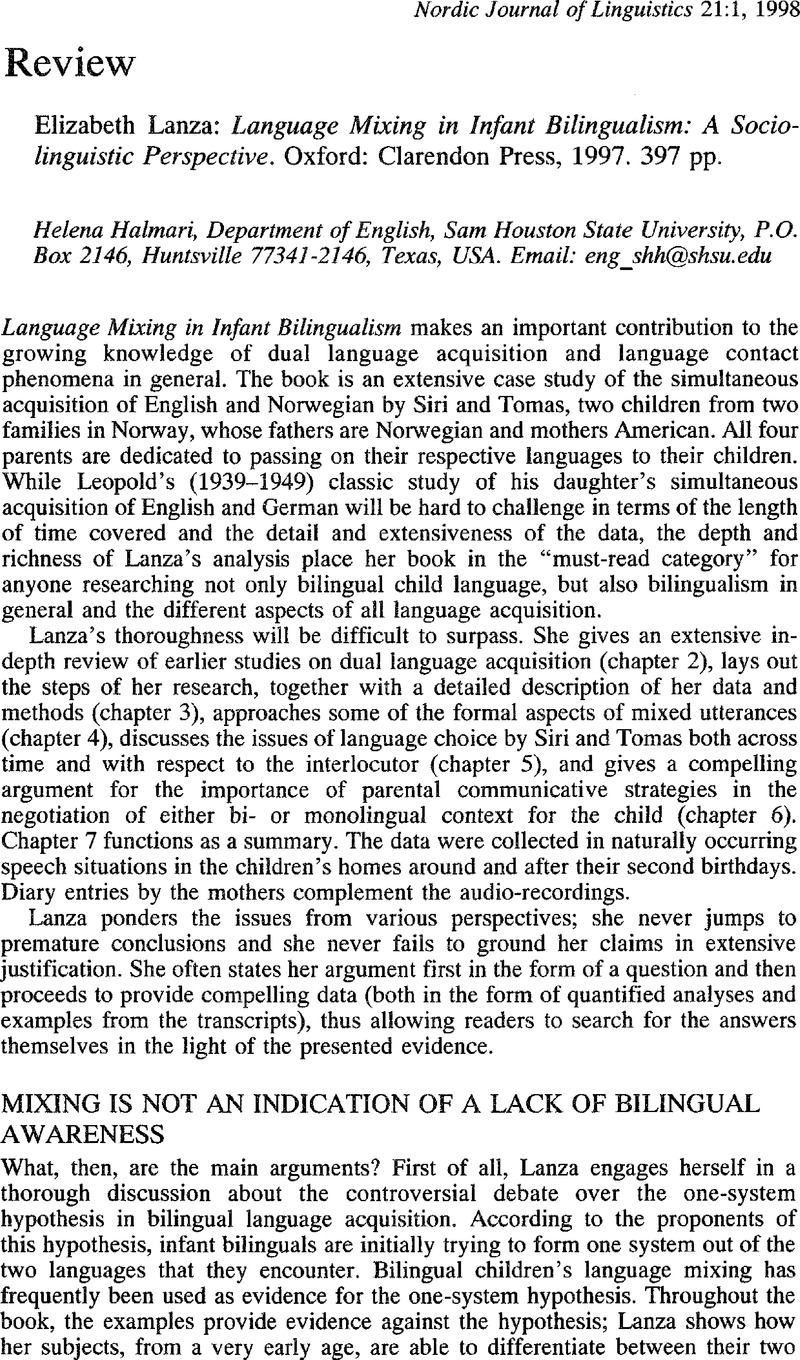No CrossRef data available.
Article contents
Elizabeth Lanza: Language Mixing in Infant Bilingualism: A Sociolinguistic Perspective. Oxford: Clarendon Press, 1997. 397 pp.
Published online by Cambridge University Press: 14 October 2010
Abstract
An abstract is not available for this content so a preview has been provided. Please use the Get access link above for information on how to access this content.

- Type
- Review
- Information
- Copyright
- Copyright © Cambridge University Press 1998
References
REFERENCES
Belazi, H. M., Rubin, E. J. & Toribio, A. J. 1994. Code Switching and X-bar Theory: The Functional Head Constraint. Linguistic Inquiry 25:2, 221–237.Google Scholar
Bentahila, A. & Davies, E. E. 1983. The Syntax of Arabic-French Code-switching. Lingua 59, 301–330.CrossRefGoogle Scholar
Bohannon, J. N. & Warren-Leubecker, A. 1989. Theoretical Approaches to Language Acquisition. In Berko Gleason, J. (ed.), The Development of Language. 2nd ed. Columbus, OH: Merrill Publishing Company, pp. 167–223.Google Scholar
Bowerman, M. 1982. Starting to Talk Worse: Clues to Language Acquisition from Children's Late Speech Errors. In Strauss, S. & Stavy, R. (eds), U-Shaped Behavioral Growth. New York: Academic Press, pp. 101–145.CrossRefGoogle Scholar
Brown, R. 1973. A First Language: The Early Stages. Cambridge, MA: Harvard University Press.CrossRefGoogle Scholar
Di Sciullo, A.-M., Muysken, P. & Singh, R. 1986. Government and Code-mixing. Journal of Linguistics 22, 1–24.CrossRefGoogle Scholar
Halmari, H. 1993. Structural Relations and Finnish-English Code Switching. Linguistics 31:6, 1043–1068.CrossRefGoogle Scholar
Halmari, H. 1997. Government and Code-switching: Explaining American Finnish. Amsterdam: John Benjamins.CrossRefGoogle Scholar
Jake, J. L. 1994. Intrasentential Code Switching and Pronouns: On the Categorial Status of Functional Elements. Linguistics 32, 271–298.CrossRefGoogle Scholar
Klavans, J. L. 1985. The Syntax of Code-switching: Spanish and English. In King, L. D. & Maley, C. A. (eds), Selected Papers from the XEIth Linguistic Symposium on Romance Languages, vol. 36. Amsterdam: John Benjamins, pp. 213–231.CrossRefGoogle Scholar
Leopold, W. F. 1939–1949. Speech Development of a Bilingual Child: A Linguist's Record, vols. i-iv. Evanston, IL: Northwestern University Press.Google Scholar
Muysken, P. 1995. Code-switching and Grammatical Theory. In Milroy, L. & Muysken, P. (eds), One Speaker, Two Languages: Cross-disciplinary Perspectives on Code Switching. Cambridge: Cambridge University Press, pp. 177–198.CrossRefGoogle Scholar
Myers-Scotton, C. 1993. Duelling Languages: Grammatical Structure in Code Switching. Oxford: Clarendon Press.CrossRefGoogle Scholar
Myers-Scotton, C. & Jake, J. L. 1995. Matching Lemmas in a Bilingual Language Competence and Production Model: Evidence from Intrasentential Code Switching. Linguistics 33, 981–1024.CrossRefGoogle Scholar
Poplack, S. 1980. “Sometimes I'll Start a Sentence in Spanish y Termino en Espan̄ol”: Toward a Typology of Code-switching. Linguistics 18:7–8, 581–618.CrossRefGoogle Scholar
Sankoff, D. & Poplack, S. 1981. A Formal Grammar for Code-switching. Papers in Linguistics 14:1, 3–46.CrossRefGoogle Scholar
Treffers-Daller, J. 1995. Code-switching between a Case-assigner and its Complement: The Case of Turkish-German Prepositional Phrases. In Summer School Code-switching and Language Contact 14–17 September 1994, Ljouwert/Leeuwarden, The Netherlands, Fryske Akademy, pp. 253–263.Google Scholar




